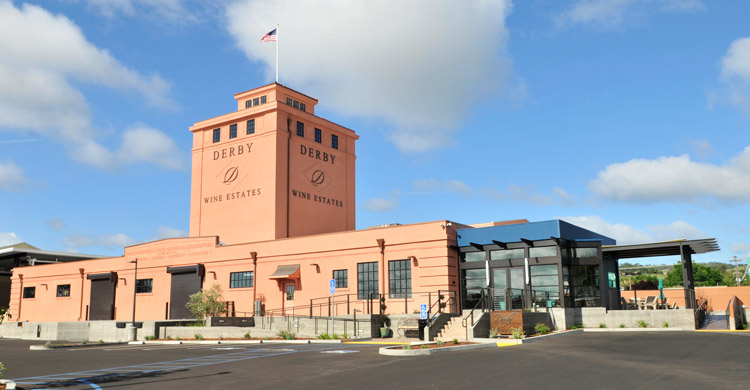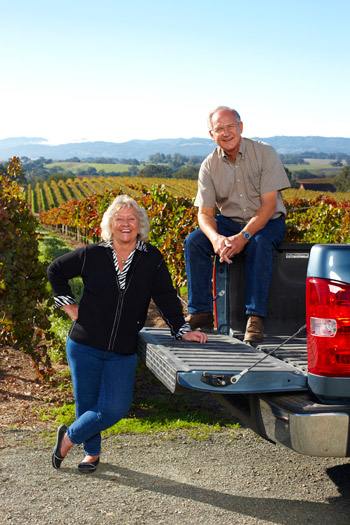
Derby Wine Estates in downtown Paso Robles
A recipe for perfection
As you enter the parking lot of Derby Wine Estates Tasting Room and Winery, your visual senses will be aroused by the sight of a perfectly restored 1922 Historic Paso Robles Building, the Old Almond Growers Exchange, later occupied by the Farmer’s Alliance Co-Op. Enter the tasting room and you will immediately be surrounded by smiles, laughter, and a genuinely enthusiastic hospitality staff, eager and ready to introduce you to Paso Robles history and Derby Wines.
Ray and Pam Derby, proprietors of Derby, have found the perfect recipe to meet you, greet you and make you feel right at home, while sipping their variety of wine-derful creations from three separate area vineyards, all while making history by preserving history.
Three distinct vineyards

Ray and Pam Derby
Sourcing from three separate vineyards with three distinct climates, producing 23 varieties of grapes – Derby Vineyard on the west side, historic Laura’s vineyard on the east side, and the Derbyshire Vineyard on the coast, near San Simeon – the wines are crafted by Winemaker Tiffinnee Vierra.
Altogether, Derby is currently growing 400 acres of grapes, producing about 3700 cases of wine per year – if it says Derby, they grow it – selling approximately 95 percent of their total grape production to a variety of small to larger producing wineries. As Ray says, they are custom farmers. And they farm their grapes to the exact specifications of each and every select customer. Seeing the Derby moniker on a label of Hug, Booker, Grey Wolf, Sans Leige and other area labels, you know you will be sipping a great wine.
Ray says: “We grow everything from Alberinio to Zinfandel’ – although their main production focuses on Cabernet Sauvignon, Syrah, Petite Syrah, Zinfandel and Merlot. However there are a variety of other small production specialties, such as their 100 percent Sparkling Pinot, produced in the method Champenoise. No short cuts here.
Ray says: “We grow everything from Alberinio to Zinfandel’ – although their main production focuses on Cabernet Sauvignon, Syrah, Petite Syrah, Zinfandel and Merlot. However there are a variety of other small production specialties, such as their 100 percent Sparkling Pinot, produced in the method Champenoise. No short cuts here.
Historical building transformed
Like the mythical Phoenix, Ray and Pam Derby took over this historic but derelict building after it stood vacant for 30 years, transformed it back to its original glory, and created a full production winery and tasting room. A labor of love and commitment, this is truly a masterpiece that rose majestically from its ashes. The passion that the Derbys feel for what they have done flows like fine wine through their entire staff – and what a story it is.
When Ray and Pam moved to Cambria in 1992 with the intent of retiring, they became interested, fascinated and obsessed with the area, the grapes and the history and purchased their first vineyard in 1998 – Derbyshire Vineyard. This was followed by the purchase of the historic Laura’s Vineyard, and several years later the Derby Vineyard.
Retirement? Forget it! A proper facility was needed to produce and showcase their wines. And now being totally immersed in the Paso Robles Wine Culture and Paso Robles history, what better than to purchase and save the elegant 1920’s Almond Growers Exchange. Today, the winery greets visitors with a sense of history, elegance, good wines and good times. Its proud tower, ask if you can climb to the top, majestically overlooks Paso Robles.
If you are fortunate enough to be able to sit down with Ray and Pam you will be mesmerized by their story, their commitment, and their love of “everything Paso.” And, as Ray will tell you, “Every customer is the most important customer in the world.”
The Derby Wine Estates tasting room, located at 525 Riverside Ave. in Paso Robles, is open daily from 11 a.m. to 5 p.m. during the winter, with extended hours until 6 p.m. in the summer. Call (805) 238-6300 or go to www.derbywineestates.com for more information; be sure to call in advance for an appointment to tour the facility.
– Don Sonderling











